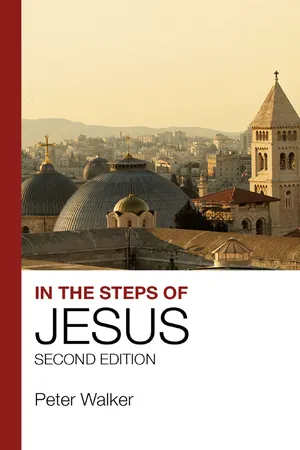
- 296 pages
- English
- ePUB (mobile friendly)
- Available on iOS & Android
About this book
Millions of people across the world have heard of Jesus Christ, but how many are truly acquainted with the key locations he frequented?
In the second edition of this established text, Peter Walker shares the fruits of his lifetime s research and expert knowledge to present a rich and engaging guide to the historical aspects of Jesus world. Following the chronology of Jesus life and ministry and drawing especially on the Gospel of Luke, we move from Bethlehem to Nazareth to the desert, and then follow him on his final journey from Galilee to Jerusalem.
In each chapter particular attention is given to what Jesus did in that location, placing his ministry within its original historical and geographical context, and raising questions of archaeology, authenticity and the recorded evidence of later pilgrims and historians. This new edition takes into account the archaeological discoveries of the last 15 years to provide an up-to-date guide to the Holy Land of today. Using maps, timelines and boxed features that highlight and analyse key topics, In the Steps of Jesus is a rich and absorbing text that presents scholars at all levels of study with a unique insight into Jesus world.
Frequently asked questions
- Essential is ideal for learners and professionals who enjoy exploring a wide range of subjects. Access the Essential Library with 800,000+ trusted titles and best-sellers across business, personal growth, and the humanities. Includes unlimited reading time and Standard Read Aloud voice.
- Complete: Perfect for advanced learners and researchers needing full, unrestricted access. Unlock 1.4M+ books across hundreds of subjects, including academic and specialized titles. The Complete Plan also includes advanced features like Premium Read Aloud and Research Assistant.
Please note we cannot support devices running on iOS 13 and Android 7 or earlier. Learn more about using the app.
Information
- Jacob and his family travelled along the ‘Way of the Patriarchs’ (from Bethel to Mamre). However, just outside Bethlehem (also known as Ephrath), his wife Rachel died while giving birth to Benjamin (the ‘son of my right hand’). So she was buried there, her tomb marked by a pillar (Genesis 35:16–20).
- The story told in the book of Ruth is located here. Ruth was originally from Moab (to the east) but had married into a Hebrew family. When her husband died, she chose to travel with her grieving mother-in-law, Naomi, back to Naomi’s hometown of Bethlehem. Here she met and married Naomi’s relative, Boaz, and became the grandmother of King David (Ruth 1–4).
- One of Israel’s greatest prophets, Samuel, came to Bethlehem to visit the family of a man called Jesse. He anointed Jesse’s youngest son, David, to succeed Saul as king of Israel (1 Samuel 16:1–13).
- Later in David’s life, Bethlehem was occupied by the Philistines and David expressed his longing to drink some water from its well. Three of his ‘mighty men’ stole into the town to fetch the water, but he refused to drink it, offering it to God instead (2 Samuel 23:13–17).
- Thereafter Bethlehem was associated with great King David and, as expectations grew that God would send another king like David, the prophet Micah predicted that, even though Bethlehem was ‘small among the clans of Judah’, yet from here would come a ‘ruler of Israel, whose origins are from of old’ (Micah 5:2–4).
Table of contents
- Cover
- Title Page
- Dedication
- Copyright
- Contents
- Introduction
- 1. Bethlehem
- 2. Nazareth
- 3. The River Jordan
- 4. The Judean Desert
- 5. Galilee and its villages
- 6. Samaria
- 7. Caesarea Philippi
- 8. Jericho
- 9. Bethany
- 10. The Mount of Olives
- 11. The Temple
- 12. Jerusalem
- 13. Golgotha and the tomb
- 14. Emmaus
- Further Reading
- Index